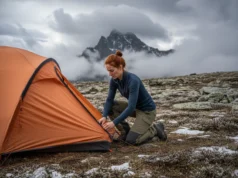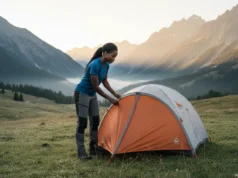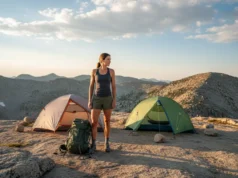In this article
The sky opens up miles from the trailhead in the Rockies, wind whipping rain sideways on a long trek. In that moment, your tent isn’t just gear; it’s your lifeline. But the ultralight tent that saved you in that storm might feel like a cramped coffin on a leisurely weekend trip. Finding the best trekking tent is the most critical gear decision you’ll make, and it’s a masterclass in balancing competing priorities. This guide isn’t just a list of backpacking tents; it’s a decision-making framework to help you invest in the perfect mobile sanctuary for your specific needs in 2025, whether you’re planning a weekend escape or a full thru-hike of the Pacific Crest Trail (PCT).
We’re going to move beyond the marketing hype to arm you with real-world knowledge. First, you’ll learn the 6 Pillars of Performance, breaking down the essential purchase criteria every hiker must understand, from the weight vs livability trade-off to durability versus packability. Next, you’ll find your Hiker Persona—discovering if you’re a Weekend Warrior, an Ultralight Thru-hiker, or a Budget-Conscious Beginner—to instantly narrow your search for the best hiking tent. We’ll then reveal our field-tested recommendations, rigorously evaluated against our expert framework. And along the way, we’ll uncover the truth about tent capacity and why the best backpacking tent 2 person models are often the smartest move for solo adventurers.
How to Choose the Right Trekking Tent: An Expert’s Framework
Why is “Livability” More Important Than Floor Area?
A spec sheet can be deceiving. A tent with a large floor area might look spacious on paper, but if the walls slope aggressively inward, you’ll find your head and shoulders pressed against damp fabric the moment you sit up. This is why seasoned hikers focus on “livability,” which is the measure of actual, usable volume and a key factor for tall-sleeper comfort. The secret to a great tent lies in modern pole architecture. Designs that use pre-bent tent poles create near-vertical walls, dramatically increasing shoulder room and effective peak height without adding significant weight. This transforms the inner tent from a restrictive cone into a comfortable, boxy living space. Quality-of-life features are also critical. A tent with two doors and two vestibules means you won’t have to climb over your tentmate, and each person gets a dedicated “mudroom” to store their wet backpack and muddy boots. Finally, small details like well-placed interior pockets and gear lofts elevate a simple shelter into an organized and comfortable backcountry home. While a comfortable interior is a luxury, remember that your shelter is the cornerstone of the Big Three in your backpacking system.
How Much Weather Resistance Do You Actually Need?
A tent’s primary job is to provide weather protection, a quality we call stormworthiness. This isn’t determined by a single feature but by a system working in concert: a strong pole architecture that enhances wind stability, a rainfly that provides full coverage all the way to the ground, and high-quality, waterproof fabrics. You’ll often see a Hydrostatic Head (HH) rating, which measures how much water pressure a fabric can withstand before leaking. Don’t get lost in the numbers; a rating of 1500mm makes for a reliable waterproof hiking tent capable of handling heavy, driving rain. The crucial trade-off here is seasonality. A 4-season tent offers ultimate protection and snow load performance for mountaineering, but it’s heavy, expensive, and has poor ventilation for milder conditions, leading to severe condensation. For the vast majority of backpackers, a well-designed 3-season tent is the versatile sweet spot, offering robust protection for everything short of an alpine blizzard. Understanding these trade-offs is fundamental to the five pillars of tent performance.
What’s the Real Cost of Shaving Ounces?
In the world of outdoor gear, you’re constantly navigating the “iron triangle” of Weight, Durability, and Price—as the saying goes, “ounces make pounds.” The quest for a lighter pack often comes at the cost of durability and impacts the final packed size. This is most evident in tent fabrics, which are measured in denier (D). A tough, budget-tier tent might use 68D sil-poly, which can handle being scraped on rocks. An ultralight backpacking tent, however, might use a wispy 15D sil-nylon that requires careful handling. For honest comparisons, always look at the minimum trail weight. Exotic materials like Dyneema Composite Fabric (DCF), found in premium ultralight tents from brands like Zpacks and Hyperlite Mountain Gear, seem to break the iron triangle by being both incredibly light and waterproof, but they do so at an astronomical price. Choosing these lighter materials means campsite selection becomes a critical skill for protecting your investment. You must learn to travel and camp on durable surfaces not just to protect the environment, but to protect your gear.
Pro-Tip: Before setting up an ultralight tent, do a quick “sweep” of your chosen spot with your hands or feet. Remove any sharp twigs, pinecones, or small rocks that could puncture the delicate floor fabric.
| Feature | Sil-Nylon | Sil-Polyester (Sil-Poly) | Dyneema Composite Fabric (DCF) |
|---|---|---|---|
| Avg. Weight | Low | Low to Medium | Extremely Low |
| Water Absorption/Sag | High (Stretches/sags when wet) | Very Low (Remains taut when wet) | None (Hydrophobic) |
| Tear Strength | High | Good | Extremely High |
| Abrasion Resistance | Good | Good | Fair to Poor (Prone to punctures) |
| UV Resistance | Fair | Good | Excellent |
| Packed Bulk | Low (Highly compressible) | Low (Highly compressible) | Medium (Stiff, does not compress well) |
| Average Cost | Low to Medium | Low to Medium | Very High |
Freestanding vs. Non-Freestanding: Which is Right for You?
The tent design fundamentally impacts its use. A freestanding tent has dedicated tent poles that hold the tent body up on its own, even before you use tent stakes. This design philosophy leads to incredible ease-of-setup, even on solid rock, and allows you to move it to find the perfect spot. Many popular models are semi-freestanding, like the Big Agnes Tiger Wall UL2, meaning the main body is supported by poles but the corners or vestibules must be staked out for full volume. In contrast, non-freestanding tents are often called trekking-pole shelters because they save weight by using your hiking poles for structure. This design, exemplified by models like the Durston X-Mid 2, achieves the lowest possible packed weight but requires suitable terrain and a higher skill level to achieve a taut pitch. The choice is clear: choose freestanding or semi-freestanding tents for convenience and versatility; opt for non-freestanding tents only if you are an ultralight enthusiast willing to master the art of the pitch.
How Do You Avoid Waking Up in a Damp Tent?
There’s nothing worse than waking up to a drip of cold water on your face. This is condensation, and it’s an unavoidable part of camping. A single person can exhale up to a pint of water vapor overnight, which will condense into liquid when it hits a cold tent surface. The key isn’t to prevent it, but to practice good condensation management. This is the genius of a double-wall tent. The inner tent body is made mostly of breathable mesh, allowing water vapor to pass through freely. That vapor then condenses on the inside of the physically separate rainfly, keeping you and your sleeping bag perfectly dry. To make this system work, you need excellent ventilation features. Look for double-walled tents with high vents in the rainfly, large mesh panels on the main tent body, and vestibule doors that can be rolled back to promote cross-breeze airflow in calm weather.
Pro-Tip: On clear, calm nights, stake your rainfly out as tautly as possible to maximize the air gap between the fly and the inner mesh. This small adjustment dramatically improves airflow and reduces condensation buildup.
Our Selection Process: How We Built This Guide
Building this guide was a deliberate process designed to earn your trust and empower your decision. Our commitment is to complete objectivity; our recommendations are the result of comprehensive market analysis, synthesizing dozens of expert in-depth reviews, long-term user feedback from trails like the CDT, and painstaking technical specification comparisons. We are not beholden to any single brand.
Every quality tent considered for this guide was tested and reviewed against the six core pillars of performance: Livability, Weather Resistance, Weight, Ease of Setup, Durability, and Ventilation. This rigorous evaluation framework ensures that every recommendation is based on balanced, real-world performance metrics across different value tiers (premium ultralight, mid-price balanced, and budget tier).
Our selection process involved two distinct phases. First, we identified three common hiker personas that represent the most common purchase criteria on the trail: the Weekend Warrior, the Budget-Conscious Beginner, and the Ultralight Thru-hiker. Second, we curated a focused selection of the highest-performing, most reputable, and best-value tents that directly serve the best-for use case of each of those personas, ensuring our picks are not just good, but perfectly suited to a specific hiking style.
Finally, a note on transparency: If you choose to purchase a product through our links, we may earn a small commission at no extra cost to you. This helps support our independent research and field testing, but our primary goal will always be to empower you with the knowledge to make the best possible choice for your adventures.
The Best Trekking Tents of 2025: Our Top Recommendations for Every Need
Our Top Picks for The Weekend Warrior (Balanced All-Rounder)
This hiker wants the perfect blend of comfort, low weight, and ease of use for weekend trips. They understand the value of a comfortable shelter and will happily accept a slight weight penalty for major gains in livability, making their time in the wilderness as relaxing as it is rewarding. They seek the best 2 person trekking tent in the mid-price balanced category, a true do-it-all backpacking tent that rivals other top contenders like the Sea to Summit Telos TR2.
Our Top Picks for The Budget-Conscious Beginner (The Value-Seeker)
This user needs a reliable, durable, and easy-to-use tent without a huge financial commitment. Weight is secondary to affordability and ruggedness for their first backpacking tent. They are looking for a trustworthy shelter in the budget tier, perhaps from REI Co-op or Marmot, that can handle the learning curve of their first few seasons on the trail without falling apart or emptying their wallet.
Conclusion
The search for the “best” tent ends when you shift your perspective. It’s not about finding a single perfect tent, but about understanding the balance of trade-offs. The right tent choice is the one that aligns with your priorities. Is your goal minimal weight for crushing long miles, maximum comfort for weekend enjoyment, or durable value for starting your backpacking journey? By now, you know that livability is about usable volume, not just floor area, and that near-vertical walls create a far more comfortable interior. You understand that freestanding tents offer supreme convenience for most backpackers, while non-freestanding trekking-pole shelters cater to the dedicated ultralight hiker. And for anyone looking for the best backpacking tent for 2, you know that two doors and two vestibules are a non-negotiable feature for quality of life on the trail.
Your perfect backcountry home is out there. Use this guide to make a confident choice, and let us know in the comments which tent you trust on your adventures—your experience could help another hiker find their perfect shelter.
Frequently Asked Questions about Trekking Tents
What is a good weight for a 2-person backpacking tent?
A good target for lightweight 2 person backpacking tents is between 3 and 4 pounds for minimum trail weight. Models designed for ultralight backpacking can dip below 2 pounds, but this often comes with significant compromises in space, durability, and cost. On the other end, budget-friendly tents can exceed 5 pounds but offer enhanced durability. For an excellent balance of weight-to-comfort ratio, a popular tent like the Big Agnes Copper Spur HV UL2 is a benchmark in the industry.
Do I need a freestanding or non-freestanding tent?
Most hikers, and especially beginners, should choose a freestanding tent. Their incredible ease of setup and versatility make them the most user-friendly option. If you are an experienced backpacker whose primary goal is shaving every possible ounce and you are comfortable using your trekking poles for structure, then a non-freestanding tent (or trekking-pole shelter) like the Durston X-Mid 2 is a fantastic lightweight option that rewards practice with a feathery pack.
Is a 1-person or 2-person tent better for a solo hiker?
For the vast majority of solo backpacking, a lightweight two person backpacking tent is the superior choice. It offers a palace of interior space, allowing you to bring your pack and gear inside, and have plenty of room to move around—all for a minor weight penalty compared to a 1P model. This greatly improves tall-sleeper suitability. A 1-person tent can often feel very cramped, and is best reserved for dedicated ultralight backpackers who prioritize minimal weight above all other considerations when choosing the best backpacking tent for two.
Are expensive DCF (Dyneema) tents worth the money?
The material value proposition for DCF tents makes sense only if your overwhelming goal is the absolute lowest pack weight. For elite ultralight thru-hikers on long trails like the PCT or CDT, the weight savings from Dyneema tents made by brands like Zpacks, Gossamer Gear, or Mountain Laurel Designs can justify the expense. However, for most backpackers, the significant price premium is not necessary. Modern sil-nylon or sil-poly tents offer an excellent blend of low weight, performance, and durability for a fraction of the cost, making them a much better value for the average adventurer.
FAQ – Frequently Asked Questions
Title: Frequently Asked Questions about Trekking Tents
Question: What is a good weight for a 2-person backpacking tent?
A good target for lightweight 2 person backpacking tents is between 3 and 4 pounds for minimum trail weight. Models designed for ultralight backpacking can dip below 2 pounds, but this often comes with significant compromises in space, durability, and cost. On the other end, budget-friendly tents can exceed 5 pounds but offer enhanced durability. For an excellent balance of weight-to-comfort ratio, a popular tent like the Big Agnes Copper Spur HV UL2 is a benchmark in the industry.
Question: Do I need a freestanding or non-freestanding tent?
Most hikers, and especially beginners, should choose a freestanding tent. Their incredible ease of setup and versatility make them the most user-friendly option. If you are an experienced backpacker whose primary goal is shaving every possible ounce and you are comfortable using your trekking poles for structure, then a non-freestanding tent (or trekking-pole shelter) like the Durston X-Mid 2 is a fantastic lightweight option that rewards practice with a feathery pack.
Question: Is a 1-person or 2-person tent better for a solo hiker?
For the vast majority of solo backpacking, a lightweight two person backpacking tent is the superior choice. It offers a palace of interior space, allowing you to bring your pack and gear inside, and have plenty of room to move around—all for a minor weight penalty compared to a 1P model. This greatly improves tall-sleeper suitability. A 1-person tent can often feel very cramped, and is best reserved for dedicated ultralight backpackers who prioritize minimal weight above all other considerations when choosing the best backpacking tent for two.
Question: Are expensive DCF (Dyneema) tents worth the money?
The material value proposition for DCF tents makes sense only if your overwhelming goal is the absolute lowest pack weight. For elite ultralight thru-hikers on long trails like the PCT or CDT, the weight savings from Dyneema tents made by brands like Zpacks, Gossamer Gear, or Mountain Laurel Designs can justify the expense. However, for most backpackers, the significant price premium is not necessary. Modern sil-nylon or sil-poly tents offer an excellent blend of low weight, performance, and durability for a fraction of the cost, making them a much better value for the average adventurer.





